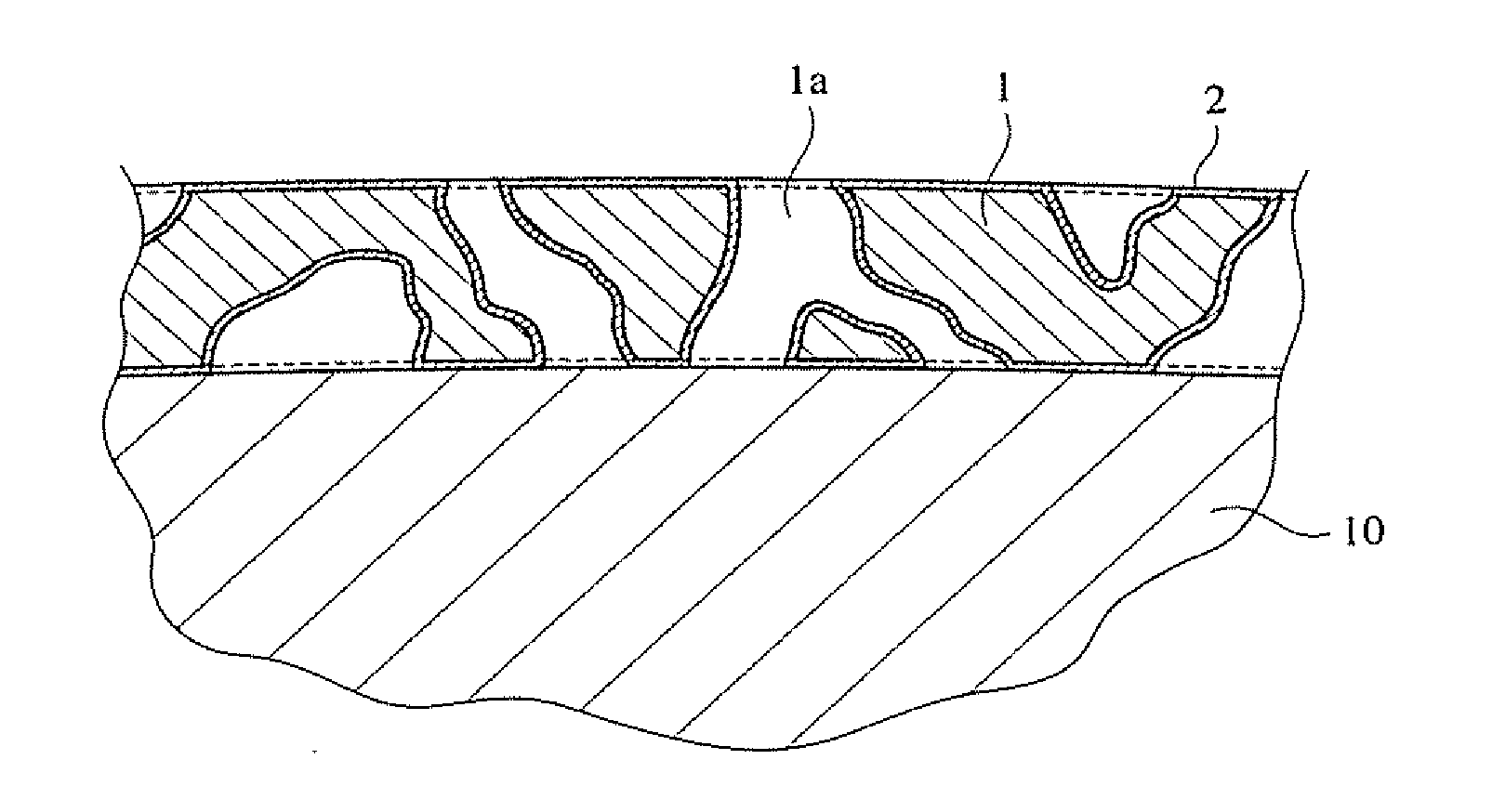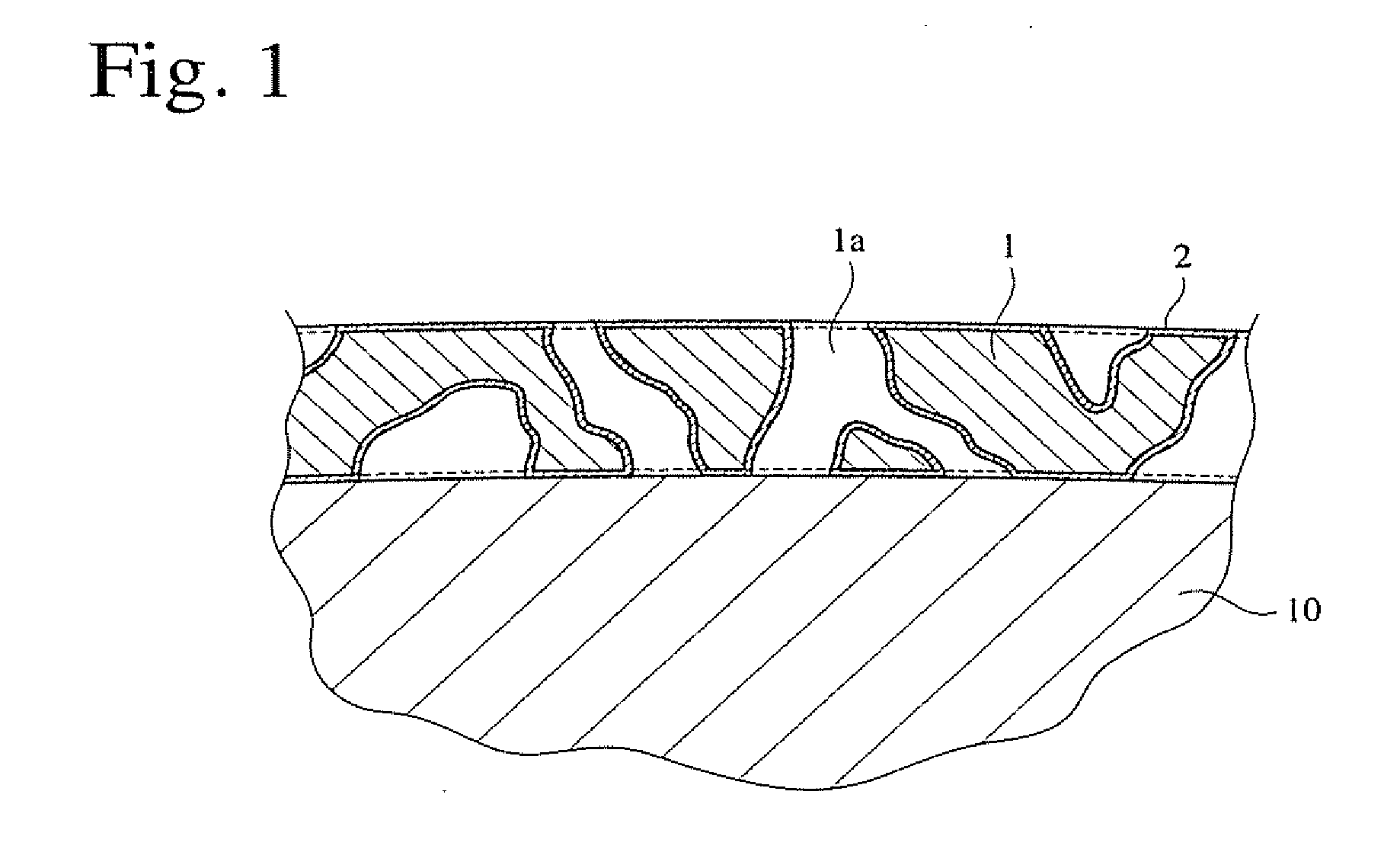Method for producing silica aerogel coating
- Summary
- Abstract
- Description
- Claims
- Application Information
AI Technical Summary
Benefits of technology
Problems solved by technology
Method used
Image
Examples
example 1
[0062] Saturated alkoxysilane (silica-skeleton-forming compound)+saturated chlorosilane (organic-modifying agent)+ultraviolet-curable resin
(1-i) Preparation of Wet Silica Gel
[0063] After 5,21 g of tetraethoxysilane was mixed with 4.38 g of ethanol, 0.4 g of hydrochloric acid (0.01 N) was added thereto, and the resultant mixture was stirred for 90 minutes. Thereafter, 44.3 g of ethanol and 0.5 g of an aqueous ammonia solution (0.02 N) were added and stirred for 46 hours. The resultant mixed liquid was aged at 60° C. for 46 hours to form a wet gel.
(1-ii) Preparation of Dispersion of Organically Modified Silica
[0064] After ethanol was added to the wet silica gel and vibrated for 10 hours, unreacted products, etc. were removed by decantation, and a dispersing medium for the wet silica gel was substituted with ethanol. Methyl isobutyl ketone (CAK) was then added to the ethanol-dispersed wet gel and vibrated for 10 hours, and the dispersing medium of ethanol was substituted with MIB...
example 2
[0070] Saturated alkoxysilane (silica-skeleton-forming compound)+saturated chlorosilane (organic-modifying agent)+ultraviolet-curable resin
(2-i) Preparation of Wet Silica Gel
[0071] 5.90 g of methyl silicate (MS51, having an average structure of a tetramethoxysilane trimer) and 50.55 g of methanol were mixed, and 3.20 g of ammonia water (0.05 N) was added to the resultant mixture and stirred for 30 minutes. The resultant mixed liquid was aged at room temperature for 72 hours to form a wet gel.
(2-ii) Preparation of Organically Modified Silica Dispersion
[0072] An organically modified wet silica gel was formed in the same manner as in the step (1-ii) in Example 1, except that the wet gel obtained in the step (2-i) was reacted with trimethylchlorosilane after the dispersing medium in the wet gel was substituted with ethanol and then with MIBK. After MIBK was added to the organically modified wet silica gel to a concentration of 3% by mass, ultrasonic irradiation was carried out in ...
example 3
[0075] Unsaturated alkoxysilane (silica-skeleton-forming compound)+saturated chlorosilane (organic-modifying agent)+ultraviolet-curable resin
(3-i) Preparation of Wet Silica Gel Having Unsaturated Bond
[0076] After 6.21 g of 3-methacryloxypropyltrimethoxysilane and 3.04 g of methanol were mixed, 0.4 g of hydrochloric acid (0.01 N) was added, and the resultant mixture was stirred at 60° C. for 3 hours. After 30.8 g of methanol and 0.5 g of an aqueous ammonia solution (0.02 N) were added thereto, the mixture was stirred for 48 hours, and aged at 60° C. for 72 hours to form a wet gel.
(3-ii) Preparation of Organically Modified Silica Dispersion
[0077] An organically modified wet silica gel was formed in the same manner as in the step (1-ii) in Example 1, except that the wet gel obtained in the step (3-i) was reacted with trimethylchlorosilane after the dispersing medium in the wet get was substituted with ethanol and then with MIBK. After MIBK was added to the organically modified we...
PUM
| Property | Measurement | Unit |
|---|---|---|
| Temperature | aaaaa | aaaaa |
| Refractive index | aaaaa | aaaaa |
Abstract
Description
Claims
Application Information
 Login to View More
Login to View More - R&D
- Intellectual Property
- Life Sciences
- Materials
- Tech Scout
- Unparalleled Data Quality
- Higher Quality Content
- 60% Fewer Hallucinations
Browse by: Latest US Patents, China's latest patents, Technical Efficacy Thesaurus, Application Domain, Technology Topic, Popular Technical Reports.
© 2025 PatSnap. All rights reserved.Legal|Privacy policy|Modern Slavery Act Transparency Statement|Sitemap|About US| Contact US: help@patsnap.com


